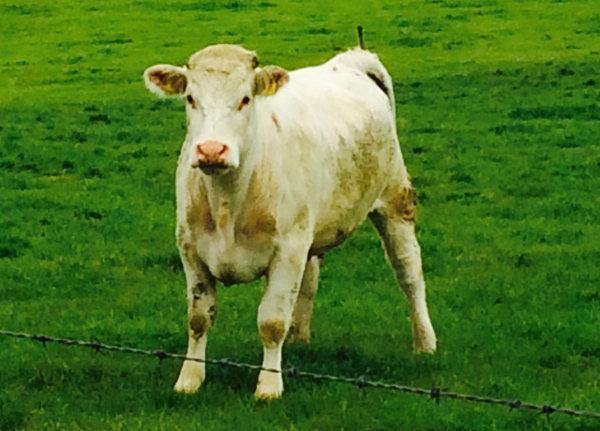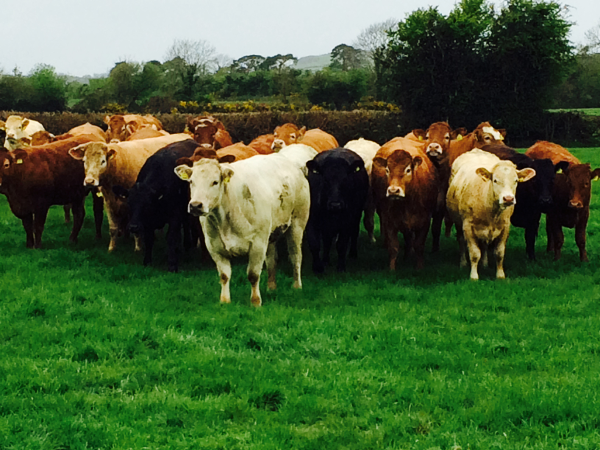 Pretty soon, the Republic of Ireland will likely be exporting beef to the United States, making it the first European country to do so in 16 years.
Pretty soon, the Republic of Ireland will likely be exporting beef to the United States, making it the first European country to do so in 16 years.
I'm told it's been an arduous process, spearheaded by Irish minister for food, agriculture and the marine Simon Coveney, who recently also took on the defense portfolio (why not?).
I met Coveney back in February, when he flew to New York City for an event in the private dining room of restaurant Daniel, celebrating the trade breakthrough.
So Ireland’s apparently taking potential beef trade with the U.S. seriously, and for good reason. Ireland produces a lot of beef. The country’s cattle herd is around 6 million, split about 50/50 between beef and dairy. That's for a human population of about four-and-a-half million.
The United States, by comparison, currently has just under 90 million beef cattle for a population of around 320 million. Ireland exports something in the neighborhood of 85 percent of its beef, mostly to other European countries, but they'd like to sell it here, too.

And we could use it: U.S. beef prices are at record highs following years of drought, first in Texas and Oklahoma in 2011 that dried up pastureland, resulting in early slaughter of many cattle, followed by drought in Midwestern corn country that resulted in higher feed prices and discouraged ranchers from rebuilding their herds.
Corn prices are down now and American cattle producers are working to raise more animals, but it takes about three years to turn a gleam in a bull's eye into a nice piece of steak, so beef prices are likely to stay high until 2017.
So lucky Ireland.
Sort of.
Although Irish whole-muscle beef is approved for importation into the United States, ground beef is still banned until Irish producers can prove to the U.S. Department of Agriculture’s satisfaction that it doesn’t need to be treated with the antimicrobial processes (steam pasteurization, acid washing or some other approved procedures) that are used in the United States.
Irish beef producers say that their ground beef is clean enough not to require that treatment, which at any rate would make it illegal for sale in Europe.
I just got back from Ireland, where I visited the plants of the five meat processors that have been, or soon will be, approved to export their beef to the U.S., and they certainly seemed clean to me. More importantly, the U.S.-based beef buyers I was traveling with were impressed, too.

I’d show you pictures of the processing plants, but camera’s aren’t allowed, so you’ll have to take my word for it. We were all garbed in white lab coats and pants and rubber boots, hair nets, beard nets and hard hats. Our hands were sanitzed and our boots were automatically scrubbed down as we walked from one section to the next, all to keep the meat safe from contamination.
The boning rooms, where the carcasses are broken down into primals and smaller cuts, smelled pristine. Even the abattoirs, where the freshly slaughtered cattle were gutted, skinned and measured by computer scanners for conformation (how well filled out the carcass is) and fat content, looked clean enough, but slaughterhouses just have a distinct smell that doesn’t bear description.
Irish beef has a good story behind it. The farms tend to be small, family owned affairs (the same is true of American cattle farms, by the way), and for most of the year the cattle feed on the lush grass that thrives on the rainy, rainy island.
Bord Bía, Ireland’s food promotion authority, measure the carbon footprint of about 90 percent of the farms, and the processors convert things like fat that’s unfit for consumption and the undigested contents of cattle's four stomachs (a big contributor to the abattoir’s distinctive smell) into a clean source of energy.

The animals are generally raised following the precepts of the “five freedoms” of animal welfare (freedom from hunger and thirst; freedom from discomfort; freedom from pain, injury or disease; freedom to express normal behavior; and freedom from fear and distress).
That means when the animals get sick, they are treated with antibiotics when necessary, meaning they can’t be sold to suppliers of antibiotic-free meat. In the United States, cattle intended to be sold as antibiotic free that get sick are treated with antibiotics and sold as commodity beef.
Irish producers can’t do that; all their beef is treated the same way.
Also, although Irish beef, unlike most American beef, don’t get finished on high-grain diets on feedlots, Irish winters are cold and wet and cattle left on the muddy pasture would damage it. So instead they’re sheltered indoors and fed a diet of silage (fermented grass) and also grain. I was told that grain makes up about one-third to half of Irish cattle's wintertime diet.
The cattle that become the grass-fed beef that we import from more temperate climates, such as Australia, New Zealand and Uruguay, can be fed completely on grass, but Irish beef generally can’t, so it can’t be sold here as grass-fed beef.
Most Irish beef is leaner than most American beef, largely because it’s finished on a lighter diet, but also because much of the herd is comprised of leaner European breeds such as Limousin and Charolais, and because their customers are accustomed to, and seek out, leaner beef. More Angus and Hereford cattle, which marble better, are being introduced, but they’re still generally leaner than U.S. beef. And in my experience they taste different — beefier, if you will, but less rich.
So Irish beef is kind of it’s own thing. Wholesome, certainly, and raised in a way that takes into account the environment, animal welfare and the livelihood of farmers. But it doesn’t fit into the strange rubric of definitions that U.S. regulators, retail marketers or the American public can wrap their heads around in a single sound bite.
There’s talk of developing a certification process for Irish beef that fits its own standards — basically the process I just described (as well as without hormone treatments, since that’s illegal in Europe) — but I think it still might take awhile to figure out just what to do with it.

